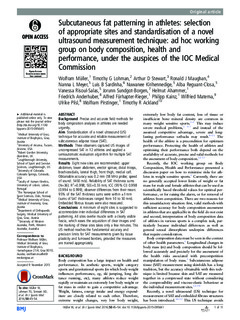| dc.contributor.author | Müller, Wolfram | |
| dc.contributor.author | Lohman, Timothy G. | |
| dc.contributor.author | Stewart, Arthur D. | |
| dc.contributor.author | Maughan, Ronald J. | |
| dc.contributor.author | Meyer, Nanna L. | |
| dc.contributor.author | Sardinha, Luis B. | |
| dc.contributor.author | Kirihennedige, Nuwanee | |
| dc.contributor.author | Reguant-Closa, Alba | |
| dc.contributor.author | Risoul-Salas, Vanessa | |
| dc.contributor.author | Sundgot-Borgen, Jorunn | |
| dc.contributor.author | Ahammer, Helmut | |
| dc.contributor.author | Anderhuber, Friedrich | |
| dc.contributor.author | Fürhapter-Rieger, Alfred | |
| dc.contributor.author | Kainz, Philipp | |
| dc.contributor.author | Materna, Wilfried | |
| dc.contributor.author | Pilsl, Ulrike | |
| dc.contributor.author | Pirstinger, Wolfram | |
| dc.contributor.author | Ackland, Timothy R. | |
| dc.date.accessioned | 2017-03-07T12:56:52Z | |
| dc.date.available | 2017-03-07T12:56:52Z | |
| dc.date.issued | 2016 | |
| dc.identifier.citation | British Journal of Sports Medicine. 2016, 50, 45-54. doi: 10.1136/bjsports-2015-095641 | nb_NO |
| dc.identifier.uri | http://hdl.handle.net/11250/2433160 | |
| dc.description.abstract | Background. Precise and accurate field methods for body composition analyses in athletes are needed urgently. Aim: Standardisation of a novel ultrasound (US) technique for accurate and reliable measurement of subcutaneous adipose tissue (SAT). Methods: Three observers captured US images of uncompressed SAT in 12 athletes and applied a semiautomatic evaluation algorithm for multiple SAT measurements. Results: Eight new sites are recommended: upper abdomen, lower abdomen, erector spinae, distal triceps, brachioradialis, lateral thigh, front thigh, medial calf. Obtainable accuracy was 0.2 mm (18 MHz probe; speed of sound: 1450 m/s). Reliability of SAT thickness sums (N=36): R2=0.998, SEE=0.55 mm, ICC (95% CI) 0.998 (0.994 to 0.999); observer differences from their mean: 95% of the SAT thickness sums were within ±1 mm (sums of SAT thicknesses ranged from 10 to 50 mm). Embedded fibrous tissues were also measured. Conclusions: A minimum of eight sites is suggested to accommodate inter-individual differences in SAT patterning. All sites overlie muscle with a clearly visible fascia, which eases the acquisition of clear images and the marking of these sites takes only a few minutes. This US method reaches the fundamental accuracy and precision limits for SAT measurements given by tissue plasticity and furrowed borders, provided the measurers are trained appropriately. | nb_NO |
| dc.language.iso | eng | nb_NO |
| dc.publisher | BMJ | nb_NO |
| dc.subject | athletic performance/physiology | nb_NO |
| dc.subject | body composition/physiology | nb_NO |
| dc.subject | body fat distribution | nb_NO |
| dc.subject | female | nb_NO |
| dc.subject | health status | nb_NO |
| dc.subject | human | nb_NO |
| dc.subject | male | nb_NO |
| dc.subject | observer variation | nb_NO |
| dc.subject | sports/*physiology | nb_NO |
| dc.subject | ultrasonography | nb_NO |
| dc.subject | muscle, skeletal/anatomy and histology/diagnostic imaging | nb_NO |
| dc.subject | subcutaneous fat/*anatomy and histology/diagnostic imaging | nb_NO |
| dc.title | Subcutaneous fat patterning in athletes: selection of appropriate sites and standardisation of a novel ultrasound measurement technique: ad hoc working group on body composition, health and performance, under the auspices of the IOC Medical Commission | nb_NO |
| dc.type | Journal article | nb_NO |
| dc.type | Peer reviewed | nb_NO |
| dc.subject.nsi | VDP::Samfunnsvitenskap: 200::Samfunnsvitenskapelige idrettsfag: 330::Andre idrettsfag: 339 | nb_NO |
| dc.source.journal | British Journal of Sports Medicine | nb_NO |
| dc.identifier.doi | 10.1136/bjsports-2015-095641 | |
| dc.description.localcode | Seksjon for idrettsmedisinske fag / Department of Sports Medicine | nb_NO |
